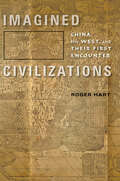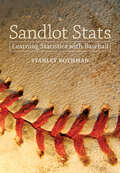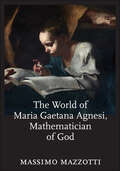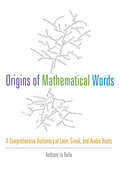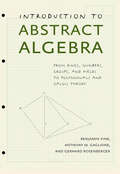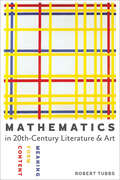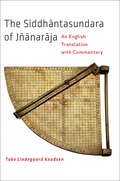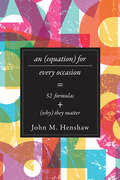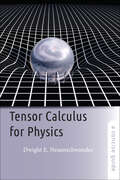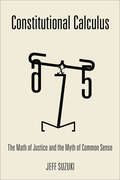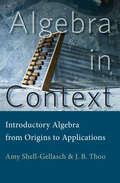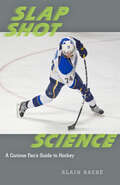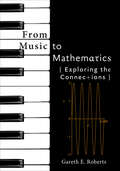- Table View
- List View
Imagined Civilizations: China, the West, and Their First Encounter
by Roger HartAccounts of the seventeenth-century Jesuit Mission to China have often celebrated it as the great encounter of two civilizations. The Jesuits portrayed themselves as wise men from the West who used mathematics and science in service of their mission. Chinese literati-official Xu Guangqi (1562–1633), who collaborated with the Italian Jesuit Matteo Ricci (1552–1610) to translate Euclid’s Elements into Chinese, reportedly recognized the superiority of Western mathematics and science and converted to Christianity. Most narratives relegate Xu and the Chinese to subsidiary roles as the Jesuits' translators, followers, and converts. Imagined Civilizations tells the story from the Chinese point of view.Using Chinese primary sources, Roger Hart focuses in particular on Xu, who was in a position of considerable power over Ricci. The result is a perspective startlingly different from that found in previous studies. Hart analyzes Chinese mathematical treatises of the period, revealing that Xu and his collaborators could not have believed their declaration of the superiority of Western mathematics. Imagined Civilizations explains how Xu’s West served as a crucial resource. While the Jesuits claimed Xu as a convert, he presented the Jesuits as men from afar who had traveled from the West to China to serve the emperor.
Introduction to Differential Equations Using Sage
by David Joyner Marshall HamptonDavid Joyner and Marshall Hampton's lucid textbook explains differential equations using the free and open-source mathematical software Sage.Since its release in 2005, Sage has acquired a substantial following among mathematicians, but its first user was Joyner, who is credited with helping famed mathematician William Stein turn the program into a usable and popular choice. Introduction to Differential Equations Using Sage extends Stein's work by creating a classroom tool that allows both differential equations and Sage to be taught concurrently. It's a creative and forward-thinking approach to math instruction.Topics include: • First-Order Differential Equations • Incorporation of Newtonian Mechanics• Second-Order Differential Equations• The Annihilator Method• Using Linear Algebra with Differential Equations• Nonlinear Systems• Partial Differential Equations• Romeo and Juliet
Introduction to Differential Equations Using Sage
by David Joyner Marshall HamptonDavid Joyner and Marshall Hampton's lucid textbook explains differential equations using the free and open-source mathematical software Sage.Since its release in 2005, Sage has acquired a substantial following among mathematicians, but its first user was Joyner, who is credited with helping famed mathematician William Stein turn the program into a usable and popular choice. Introduction to Differential Equations Using Sage extends Stein's work by creating a classroom tool that allows both differential equations and Sage to be taught concurrently. It's a creative and forward-thinking approach to math instruction.Topics include: • First-Order Differential Equations • Incorporation of Newtonian Mechanics• Second-Order Differential Equations• The Annihilator Method• Using Linear Algebra with Differential Equations• Nonlinear Systems• Partial Differential Equations• Romeo and Juliet
Least Squares Data Fitting with Applications
by Per Christian Hansen Víctor Pereyra Godela SchererAs one of the classical statistical regression techniques, and often the first to be taught to new students, least squares fitting can be a very effective tool in data analysis. Given measured data, we establish a relationship between independent and dependent variables so that we can use the data predictively. The main concern of Least Squares Data Fitting with Applications is how to do this on a computer with efficient and robust computational methods for linear and nonlinear relationships. The presentation also establishes a link between the statistical setting and the computational issues.In a number of applications, the accuracy and efficiency of the least squares fit is central, and Per Christian Hansen, Víctor Pereyra, and Godela Scherer survey modern computational methods and illustrate them in fields ranging from engineering and environmental sciences to geophysics. Anyone working with problems of linear and nonlinear least squares fitting will find this book invaluable as a hands-on guide, with accessible text and carefully explained problems.Included are• an overview of computational methods together with their properties and advantages• topics from statistical regression analysis that help readers to understand and evaluate the computed solutions• many examples that illustrate the techniques and algorithmsLeast Squares Data Fitting with Applications can be used as a textbook for advanced undergraduate or graduate courses and professionals in the sciences and in engineering.
Least Squares Data Fitting with Applications
by Per Christian Hansen Víctor Pereyra Godela SchererAs one of the classical statistical regression techniques, and often the first to be taught to new students, least squares fitting can be a very effective tool in data analysis. Given measured data, we establish a relationship between independent and dependent variables so that we can use the data predictively. The main concern of Least Squares Data Fitting with Applications is how to do this on a computer with efficient and robust computational methods for linear and nonlinear relationships. The presentation also establishes a link between the statistical setting and the computational issues.In a number of applications, the accuracy and efficiency of the least squares fit is central, and Per Christian Hansen, Víctor Pereyra, and Godela Scherer survey modern computational methods and illustrate them in fields ranging from engineering and environmental sciences to geophysics. Anyone working with problems of linear and nonlinear least squares fitting will find this book invaluable as a hands-on guide, with accessible text and carefully explained problems.Included are• an overview of computational methods together with their properties and advantages• topics from statistical regression analysis that help readers to understand and evaluate the computed solutions• many examples that illustrate the techniques and algorithmsLeast Squares Data Fitting with Applications can be used as a textbook for advanced undergraduate or graduate courses and professionals in the sciences and in engineering.
Matrix Computations (Johns Hopkins Studies in the Mathematical Sciences #3)
by Gene H. Golub Charles F. Van LoanThe fourth edition of Gene H. Golub and Charles F. Van Loan's classic is an essential reference for computational scientists and engineers in addition to researchers in the numerical linear algebra community. Anyone whose work requires the solution to a matrix problem and an appreciation of its mathematical properties will find this book to be an indispensible tool. This revision is a cover-to-cover expansion and renovation of the third edition. It now includes an introduction to tensor computations and brand new sections on • fast transforms• parallel LU• discrete Poisson solvers• pseudospectra• structured linear equation problems• structured eigenvalue problems• large-scale SVD methods• polynomial eigenvalue problems Matrix Computations is packed with challenging problems, insightful derivations, and pointers to the literature—everything needed to become a matrix-savvy developer of numerical methods and software. The second most cited math book of 2012 according to MathSciNet, the book has placed in the top 10 for since 2005.
Matrix Computations: Selected Works Of Gene H. Golub With Commentaries (Johns Hopkins Studies in the Mathematical Sciences #3)
by Gene H. Golub Charles F. van Van LoanThe fourth edition of Gene H. Golub and Charles F. Van Loan's classic is an essential reference for computational scientists and engineers in addition to researchers in the numerical linear algebra community. Anyone whose work requires the solution to a matrix problem and an appreciation of its mathematical properties will find this book to be an indispensible tool. This revision is a cover-to-cover expansion and renovation of the third edition. It now includes an introduction to tensor computations and brand new sections on • fast transforms• parallel LU• discrete Poisson solvers• pseudospectra• structured linear equation problems• structured eigenvalue problems• large-scale SVD methods• polynomial eigenvalue problems Matrix Computations is packed with challenging problems, insightful derivations, and pointers to the literature—everything needed to become a matrix-savvy developer of numerical methods and software. The second most cited math book of 2012 according to MathSciNet, the book has placed in the top 10 for since 2005.
Sandlot Stats: Learning Statistics with Baseball
by Stanley RothmanAs Derek Jeter strolls toward the plate, the announcer tosses out a smattering of statistics—from hitting streaks to batting averages. But what do the numbers mean? And how can America’s favorite pastime be a model for learning about statistics? Sandlot Stats is an innovative textbook that explains the mathematical underpinnings of baseball so that students can understand the world of statistics and probability. Carefully illustrated and filled with exercises and examples, this book teaches the fundamentals of probability and statistics through the feats of baseball legends such as Hank Aaron, Joe DiMaggio, and Ted Williams—and more recent players such as Barry Bonds, Albert Pujols, and Alex Rodriguez. Exercises require only pen-and-paper or Microsoft Excel to perform the analyses.Sandlot Stats covers all the bases, including• descriptive and inferential statistics• linear regression and correlation• probability• sports betting• probability distribution functions• sampling distributions• hypothesis testing• confidence intervals• chi-square distributionSandlot Stats offers information covered in most introductory statistics books, yet is peppered with interesting facts from the history of baseball to enhance the interest of the student and make learning fun.
Sandlot Stats: Learning Statistics with Baseball
by Stanley RothmanAs Derek Jeter strolls toward the plate, the announcer tosses out a smattering of statistics—from hitting streaks to batting averages. But what do the numbers mean? And how can America’s favorite pastime be a model for learning about statistics? Sandlot Stats is an innovative textbook that explains the mathematical underpinnings of baseball so that students can understand the world of statistics and probability. Carefully illustrated and filled with exercises and examples, this book teaches the fundamentals of probability and statistics through the feats of baseball legends such as Hank Aaron, Joe DiMaggio, and Ted Williams—and more recent players such as Barry Bonds, Albert Pujols, and Alex Rodriguez. Exercises require only pen-and-paper or Microsoft Excel to perform the analyses.Sandlot Stats covers all the bases, including• descriptive and inferential statistics• linear regression and correlation• probability• sports betting• probability distribution functions• sampling distributions• hypothesis testing• confidence intervals• chi-square distributionSandlot Stats offers information covered in most introductory statistics books, yet is peppered with interesting facts from the history of baseball to enhance the interest of the student and make learning fun.
The World of Maria Gaetana Agnesi, Mathematician of God (Johns Hopkins Studies in the History of Mathematics #2)
by Massimo MazzottiShe is best known for her curve, the witch of Agnesi, which appears in almost all high school and undergraduate math books. She was a child prodigy who frequented the salon circuit, discussing mathematics, philosophy, history, and music in multiple languages. She wrote one of the first vernacular textbooks on calculus and was appointed chair of mathematics at the university in Bologna. In later years, however, she became a prominent figure within the Catholic Enlightenment, gave up academics, and devoted herself to the poor, the sick, the hungry, and the homeless. Indeed, the life of Maria Agnesi reveals a complex and enigmatic figure—one of the most fascinating characters in the history of mathematics. Using newly discovered archival documents, Massimo Mazzotti reconstructs the wide spectrum of Agnesi's social experience and examines her relationships to various traditions—religious, political, social, and mathematical. This meticulous study shows how she and her fellow Enlightenment Catholics modified tradition in an effort to reconcile aspects of modern philosophy and science with traditional morality and theology.Mazzotti's original and provocative investigation is also the first targeted study of the Catholic Enlightenment and its influence on modern science. He argues that Agnesi's life is the perfect lens through which we can gain a greater understanding of mid-eighteenth-century cultural trends in continental Europe.
Origins of Mathematical Words: A Comprehensive Dictionary of Latin, Greek, and Arabic Roots
by Anthony Lo BelloDo you ever wonder about the origins of mathematical terms such as ergodic, biholomorphic, and strophoid? Here Anthony Lo Bello explains the roots of these and better-known words like asymmetric, gradient, and average. He provides Greek, Latin, and Arabic text in its original form to enhance each explanation. This sophisticated, one-of-a-kind reference for mathematicians and word lovers is based on decades of the author's painstaking research and work.Origins of Mathematical Words supplies definitions for words such as conchoid (a shell-shaped curve derived from the Greek noun for "mussel") and zenith (Arabic for "way overhead"), as well as approximation (from the Latin proximus, meaning "nearest"). These and hundreds of other terms wait to be discovered within the pages of this mathematical and etymological treasure chest.
Origins of Mathematical Words: A Comprehensive Dictionary of Latin, Greek, and Arabic Roots
by Anthony Lo BelloDo you ever wonder about the origins of mathematical terms such as ergodic, biholomorphic, and strophoid? Here Anthony Lo Bello explains the roots of these and better-known words like asymmetric, gradient, and average. He provides Greek, Latin, and Arabic text in its original form to enhance each explanation. This sophisticated, one-of-a-kind reference for mathematicians and word lovers is based on decades of the author's painstaking research and work.Origins of Mathematical Words supplies definitions for words such as conchoid (a shell-shaped curve derived from the Greek noun for "mussel") and zenith (Arabic for "way overhead"), as well as approximation (from the Latin proximus, meaning "nearest"). These and hundreds of other terms wait to be discovered within the pages of this mathematical and etymological treasure chest.
Introduction to Abstract Algebra: From Rings, Numbers, Groups, and Fields to Polynomials and Galois Theory
by Benjamin Fine Anthony M. Gaglione Gerhard RosenbergerIntroduction to Abstract Algebra presents a breakthrough approach to teaching one of math's most intimidating concepts. Avoiding the pitfalls common in the standard textbooks, Benjamin Fine, Anthony M. Gaglione, and Gerhard Rosenberger set a pace that allows beginner-level students to follow the progression from familiar topics such as rings, numbers, and groups to more difficult concepts. Classroom tested and revised until students achieved consistent, positive results, this textbook is designed to keep students focused as they learn complex topics. Fine, Gaglione, and Rosenberger's clear explanations prevent students from getting lost as they move deeper and deeper into areas such as abelian groups, fields, and Galois theory. This textbook will help bring about the day when abstract algebra no longer creates intense anxiety but instead challenges students to fully grasp the meaning and power of the approach. Topics covered include:• Rings• Integral domains• The fundamental theorem of arithmetic• Fields• Groups• Lagrange's theorem• Isomorphism theorems for groups• Fundamental theorem of finite abelian groups• The simplicity of An for n5• Sylow theorems• The Jordan-Hölder theorem• Ring isomorphism theorems• Euclidean domains• Principal ideal domains• The fundamental theorem of algebra• Vector spaces• Algebras• Field extensions: algebraic and transcendental• The fundamental theorem of Galois theory• The insolvability of the quintic
Introduction to Abstract Algebra: From Rings, Numbers, Groups, and Fields to Polynomials and Galois Theory
by Benjamin Fine Gerhard Rosenberger Anthony M. GaglioneIntroduction to Abstract Algebra presents a breakthrough approach to teaching one of math's most intimidating concepts. Avoiding the pitfalls common in the standard textbooks, Benjamin Fine, Anthony M. Gaglione, and Gerhard Rosenberger set a pace that allows beginner-level students to follow the progression from familiar topics such as rings, numbers, and groups to more difficult concepts. Classroom tested and revised until students achieved consistent, positive results, this textbook is designed to keep students focused as they learn complex topics. Fine, Gaglione, and Rosenberger's clear explanations prevent students from getting lost as they move deeper and deeper into areas such as abelian groups, fields, and Galois theory. This textbook will help bring about the day when abstract algebra no longer creates intense anxiety but instead challenges students to fully grasp the meaning and power of the approach. Topics covered include:• Rings• Integral domains• The fundamental theorem of arithmetic• Fields• Groups• Lagrange's theorem• Isomorphism theorems for groups• Fundamental theorem of finite abelian groups• The simplicity of An for n5• Sylow theorems• The Jordan-Hölder theorem• Ring isomorphism theorems• Euclidean domains• Principal ideal domains• The fundamental theorem of algebra• Vector spaces• Algebras• Field extensions: algebraic and transcendental• The fundamental theorem of Galois theory• The insolvability of the quintic
Mathematics in Twentieth-Century Literature and Art: Content, Form, Meaning
by Robert TubbsDuring the twentieth century, many artists and writers turned to abstract mathematical ideas to help them realize their aesthetic ambitions. Man Ray, Marcel Duchamp, and, perhaps most famously, Piet Mondrian used principles of mathematics in their work. Was it mere coincidence, or were these artists simply following their instincts, which in turn were ruled by mathematical underpinnings, such as optimal solutions for filling a space? If math exists within visual art, can it be found within literary pursuits? In short, just what is the relationship between mathematics and the creative arts?In this provocative, original exploration of mathematical ideas in art and literature, Robert Tubbs argues that the links are much stronger than previously imagined and exceed both coincidence and commonality of purpose. Not only does he argue that mathematical ideas guided the aesthetic visions of many twentieth-century artists and writers, Tubbs further asserts that artists and writers used math in their creative processes even though they seemed to have no affinity for mathematical thinking. In the end, Tubbs makes the case that art can be better appreciated when the math that inspired it is better understood. An insightful tour of the great masters of the last century and an argument that challenges long-held paradigms, Mathematics in Twentieth-Century Literature and Art will appeal to mathematicians, humanists, and artists, as well as instructors teaching the connections among math, literature, and art.
The Siddhantasundara of Jñanaraja: An English Translation with Commentary
by Toke Lindegaard KnudsenA treasure for anyone interested in early modern India and the history of mathematics, this first English translation of the Siddhantasundara reveals the fascinating work of the scholar-astronomer Jñanaraja (circa 1500 C.E.). Toke Lindegaard Knudsen begins with an introduction to the traditions of ancient Hindu astronomy and describes what is known of Jñanaraja’s life and family. He translates the Sanskrit verses into English and offers expert commentary on the style and substance of Jñanaraja's treatise.The Siddhantasundara contains a comprehensive exposition of the system of Indian astronomy, including how to compute planetary positions and eclipses. It also explores deep, probing questions about the workings of the universe and sacred Hindu traditions. In a philosophical discussion, the treatise seeks a synthesis between the cosmological model used by the Indian astronomical tradition and the cosmology of a class of texts sacred in Hinduism. In his discourse, which includes a discussion of the direction of down and adhesive antipodeans, Jñanaraja rejects certain principles from the astronomical tradition and reinterprets principles from the sacred texts. He also constructs a complex poem on the seasons, many verses of which have two layers of meaning, one describing a season, the other a god's activities in that season. The Siddhantasundara is the last major treatise of Indian astronomy and cosmology to receive serious scholarly attention, Knudsen’s careful effort unveils the 500-year-old Sanskrit verses and shows the clever quirkiness of Jñanaraja's writing style, his keen use of mathematics, and his subtle philosophical arguments.
The Siddhantasundara of Jñanaraja: An English Translation with Commentary
by Toke Lindegaard KnudsenA treasure for anyone interested in early modern India and the history of mathematics, this first English translation of the Siddhantasundara reveals the fascinating work of the scholar-astronomer Jñanaraja (circa 1500 C.E.). Toke Lindegaard Knudsen begins with an introduction to the traditions of ancient Hindu astronomy and describes what is known of Jñanaraja’s life and family. He translates the Sanskrit verses into English and offers expert commentary on the style and substance of Jñanaraja's treatise.The Siddhantasundara contains a comprehensive exposition of the system of Indian astronomy, including how to compute planetary positions and eclipses. It also explores deep, probing questions about the workings of the universe and sacred Hindu traditions. In a philosophical discussion, the treatise seeks a synthesis between the cosmological model used by the Indian astronomical tradition and the cosmology of a class of texts sacred in Hinduism. In his discourse, which includes a discussion of the direction of down and adhesive antipodeans, Jñanaraja rejects certain principles from the astronomical tradition and reinterprets principles from the sacred texts. He also constructs a complex poem on the seasons, many verses of which have two layers of meaning, one describing a season, the other a god's activities in that season. The Siddhantasundara is the last major treatise of Indian astronomy and cosmology to receive serious scholarly attention, Knudsen’s careful effort unveils the 500-year-old Sanskrit verses and shows the clever quirkiness of Jñanaraja's writing style, his keen use of mathematics, and his subtle philosophical arguments.
An Equation for Every Occasion: Fifty-Two Formulas and Why They Matter
by John M. HenshawWith this fun romp through the world of equations we encounter in our everyday lives, you’ll find yourself flipping through the stories of fifty-two formulas faster than a deck of cards. John M. Henshaw’s intriguing true accounts, each inspired by a different mathematical equation, are both succinct and easy to read. His tales come from the spheres of sports, business, history, the arts, science, and technology. Anecdotes about famous equations, like E=mc2, appear alongside tales of not-so-famous—but equally fascinating—equations, such as the one used to determine the SPF number for sunscreen. Drawn from the breadth of human endeavor, Henshaw's stories demonstrate the power and utility of math. He entertains us by exploring the ways that equations can be used to explain, among other things, Ponzi schemes, the placebo effect, "dog years," IQ, the wave mechanics of tsunamis, the troubled modern beekeeping industry, and the Challenger disaster. Smartly conceived and fast paced, his book offers something for anyone curious about math and its impacts.
An Equation for Every Occasion: Fifty-Two Formulas and Why They Matter
by John M. HenshawWith this fun romp through the world of equations we encounter in our everyday lives, you;€™ll find yourself flipping through the stories of fifty-two formulas faster than a deck of cards. John M. Henshaw;€™s intriguing true accounts, each inspired by a different mathematical equation, are both succinct and easy to read. His tales come from the spheres of sports, business, history, the arts, science, and technology. Anecdotes about famous equations, like E=mc2, appear alongside tales of not-so-famous;¢;‚¬;€?but equally fascinating;¢;‚¬;€?equations, such as the one used to determine the SPF number for sunscreen. Drawn from the breadth of human endeavor, Henshaw's stories demonstrate the power and utility of math. He entertains us by exploring the ways that equations can be used to explain, among other things, Ponzi schemes, the placebo effect, "dog years," IQ, the wave mechanics of tsunamis, the troubled modern beekeeping industry, and the Challenger disaster. Smartly conceived and fast paced, his book offers something for anyone curious about math and its impacts.
Tensor Calculus for Physics: A Concise Guide
by Dwight E. NeuenschwanderUnderstanding tensors is essential for any physics student dealing with phenomena where causes and effects have different directions. A horizontal electric field producing vertical polarization in dielectrics; an unbalanced car wheel wobbling in the vertical plane while spinning about a horizontal axis; an electrostatic field on Earth observed to be a magnetic field by orbiting astronauts�these are some situations where physicists employ tensors. But the true beauty of tensors lies in this fact: When coordinates are transformed from one system to another, tensors change according to the same rules as the coordinates. Tensors, therefore, allow for the convenience of coordinates while also transcending them. This makes tensors the gold standard for expressing physical relationships in physics and geometry. Undergraduate physics majors are typically introduced to tensors in special-case applications. For example, in a classical mechanics course, they meet the "inertia tensor," and in electricity and magnetism, they encounter the "polarization tensor." However, this piecemeal approach can set students up for misconceptions when they have to learn about tensors in more advanced physics and mathematics studies (e.g., while enrolled in a graduate-level general relativity course or when studying non-Euclidean geometries in a higher mathematics class). Dwight E. Neuenschwander's Tensor Calculus for Physics is a bottom-up approach that emphasizes motivations before providing definitions. Using a clear, step-by-step approach, the book strives to embed the logic of tensors in contexts that demonstrate why that logic is worth pursuing. It is an ideal companion for courses such as mathematical methods of physics, classical mechanics, electricity and magnetism, and relativity.
Constitutional Calculus: The Math of Justice and the Myth of Common Sense
by Jeff SuzukiHow should we count the population of the United States? What would happen if we replaced the electoral college with a direct popular vote? What are the consequences of allowing unlimited partisan gerrymandering of congressional districts? Can six-person juries yield verdicts consistent with the needs of justice? Is it racist to stop and frisk minorities at a higher rate than non-minorities? These and other questions have long been the subject of legal and political debate and are routinely decided by lawyers, politicians, judges, and voters, mostly through an appeal to common sense and tradition.But mathematician Jeff Suzuki asserts that common sense is not so common, and traditions developed long ago in what was a mostly rural, mostly agricultural, mostly isolated nation of three million might not apply to a mostly urban, mostly industrial, mostly global nation of three hundred million. In Constitutional Calculus, Suzuki guides us through the U.S. Constitution and American history to show how mathematics reveals our flaws, finds the answers we need, and moves us closer to our ideals. From the first presidential veto to the debate over mandatory drug testing, the National Security Agency's surveillance program, and the fate of death row inmates, Suzuki draws us into real-world debates and then reveals how math offers a superior compass for decision-making. Relying on iconic cases, including the convictions of the Scottsboro boys, League of United Latin American Citizens v. Perry, and Floyd v. City of New York, Suzuki shows that more math can lead to better justice, greater fairness, and a more stable democracy. Whether you are fascinated by history, math, social justice, or government, your interest will be piqued and satisfied by the convincing case Suzuki makes.
Algebra in Context: Introductory Algebra from Origins to Applications
by Amy Shell-Gellasch John ThooThis book’s unique approach to the teaching of mathematics lies in its use of history to provide a framework for understanding algebra and related fields. With Algebra in Context, students will soon discover why mathematics is such a crucial part not only of civilization but also of everyday life. Even those who have avoided mathematics for years will find the historical stories both inviting and gripping.The book’s lessons begin with the creation and spread of number systems, from the mathematical development of early civilizations in Babylonia, Greece, China, Rome, Egypt, and Central America to the advancement of mathematics over time and the roles of famous figures such as Descartes and Leonardo of Pisa (Fibonacci). Before long, it becomes clear that the simple origins of algebra evolved into modern problem solving. Along the way, the language of mathematics becomes familiar, and students are gradually introduced to more challenging problems. Paced perfectly, Amy Shell-Gellasch and J. B. Thoo’s chapters ease students from topic to topic until they reach the twenty-first century. By the end of Algebra in Context, students using this textbook will be comfortable with most algebra concepts, including • Different number bases • Algebraic notation • Methods of arithmetic calculation • Real numbers • Complex numbers • Divisors • Prime factorization • Variation • Factoring • Solving linear equations • False position • Solving quadratic equations • Solving cubic equations • nth roots • Set theory • One-to-one correspondence • Infinite sets • Figurate numbers • Logarithms • Exponential growth • Interest calculations
Slap Shot Science: A Curious Fan's Guide to Hockey
by Alain HachéFrom the moment the first player steps onto the ice, every conceivable principle of science is in play. To understand hockeyâ€�fully understand itâ€�Alain Haché argues that you must first learn how ice reacts to a passing blade, how the trajectory and aerodynamics of the puck affect its chances of getting into the net, how the tension on the stick transfers energy to the puck, and dozens of other details of the game.Slap Shot Science is an under-the-hood, behind-the-scenes, action-packed romp through special moments in the game as seen from the perspective of science and explained in a way everyone can understand. Among the topics Haché discusses are the differences between real ice and synthetic ice, the perfect amount of sharpness for a skate, how goalies can make spectacular saves even though the puck is traveling 100 miles per hour, whether players are skating faster today than in years past, and how equipment prevents many serious injuries. Slap Shot Science shows us how statistics can predict future performance by players and teams and why they can also be misused in many ways. By the close of the book you’ll see hockey in a more sophisticated and scientific light, and the reasons things happen the way they do will be clearer than ever.
From Music to Mathematics: Exploring the Connections
by Gareth E. RobertsTaking a "music first" approach, Gareth E. Roberts's From Music to Mathematics will inspire students to learn important, interesting, and at times advanced mathematics. Ranging from a discussion of the geometric sequences and series found in the rhythmic structure of music to the phase-shifting techniques of composer Steve Reich, the musical concepts and examples in the book motivate a deeper study of mathematics.Comprehensive and clearly written, From Music to Mathematics is designed to appeal to readers without specialized knowledge of mathematics or music. Students are taught the relevant concepts from music theory (notation, scales, intervals, the circle of fifths, tonality, etc.), with the pertinent mathematics developed alongside the related musical topic. The mathematics advances in level of difficulty from calculating with fractions, to manipulating trigonometric formulas, to constructing group multiplication tables and proving a number is irrational. Topics discussed in the book include Rhythm Introductory music theory The science of sound Tuning and temperament Symmetry in music The Bartók controversy Change ringing Twelve-tone music Mathematical modern music The Hemachandra–Fibonacci numbers and the golden ratio Magic squares Phase shiftingFeaturing numerous musical excerpts, including several from jazz and popular music, each topic is presented in a clear and in-depth fashion. Sample problems are included as part of the exposition, with carefully written solutions provided to assist the reader. The book also contains more than 200 exercises designed to help develop students' analytical skills and reinforce the material in the text. From the first chapter through the last, readers eager to learn more about the connections between mathematics and music will find a comprehensive textbook designed to satisfy their natural curiosity.
From Music to Mathematics: Exploring the Connections
by Gareth E. RobertsTaking a "music first" approach, Gareth E. Roberts's From Music to Mathematics will inspire students to learn important, interesting, and at times advanced mathematics. Ranging from a discussion of the geometric sequences and series found in the rhythmic structure of music to the phase-shifting techniques of composer Steve Reich, the musical concepts and examples in the book motivate a deeper study of mathematics.Comprehensive and clearly written, From Music to Mathematics is designed to appeal to readers without specialized knowledge of mathematics or music. Students are taught the relevant concepts from music theory (notation, scales, intervals, the circle of fifths, tonality, etc.), with the pertinent mathematics developed alongside the related musical topic. The mathematics advances in level of difficulty from calculating with fractions, to manipulating trigonometric formulas, to constructing group multiplication tables and proving a number is irrational. Topics discussed in the book include Rhythm Introductory music theory The science of sound Tuning and temperament Symmetry in music The Bartók controversy Change ringing Twelve-tone music Mathematical modern music The Hemachandra–Fibonacci numbers and the golden ratio Magic squares Phase shiftingFeaturing numerous musical excerpts, including several from jazz and popular music, each topic is presented in a clear and in-depth fashion. Sample problems are included as part of the exposition, with carefully written solutions provided to assist the reader. The book also contains more than 200 exercises designed to help develop students' analytical skills and reinforce the material in the text. From the first chapter through the last, readers eager to learn more about the connections between mathematics and music will find a comprehensive textbook designed to satisfy their natural curiosity.
